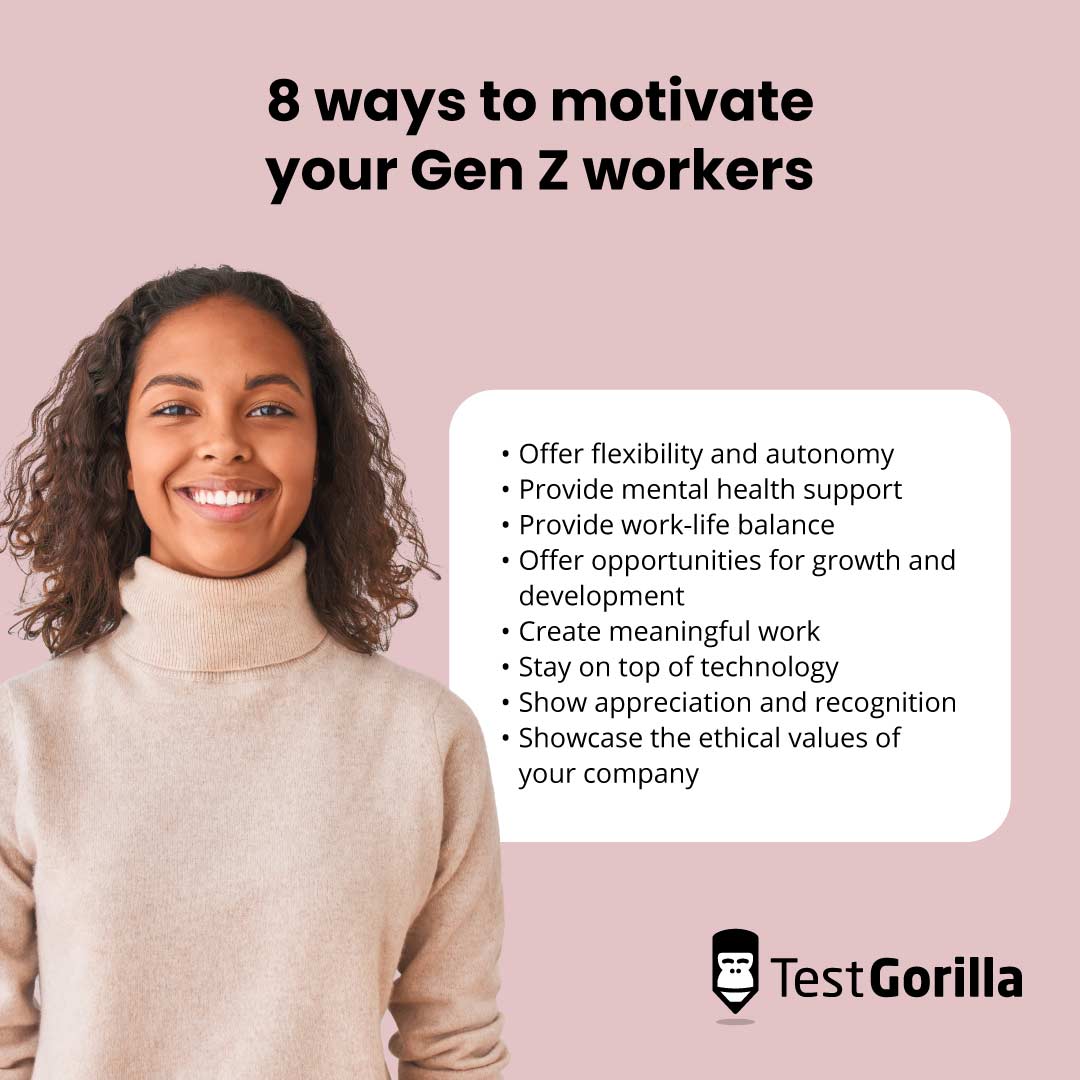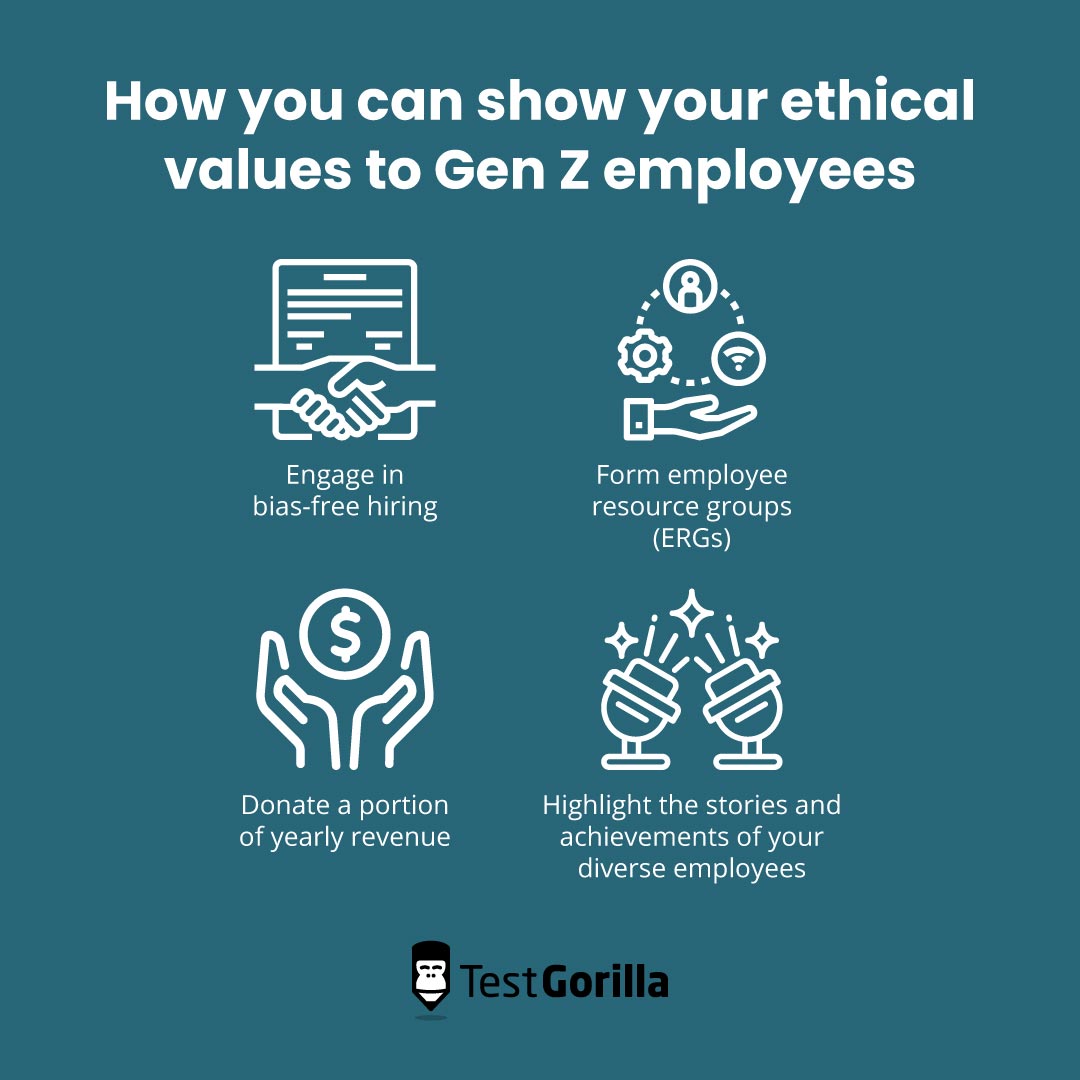Recruiting and retaining Gen Z can be tricky. Joining the workplace during the years of the pandemic, the Great Reshuffle, and quiet quitting, they tend not to stay in the same jobs as long as previous generations, with 40% wanting to leave within two years. 35% would leave even without having another position lined up.[1]
However, certain things are very important to this demographic, for example, managers they can trust, a healthy work-life balance, and a company’s dedication to diversity and inclusion.
By getting your company values, policies, and mission right, you can attract Gen Z candidates and motivate them to bring their best selves to the job.
In this piece, we’ll look at what’s important to Gen Z at work and how you can adjust your company values, policies, and mission to get the best out of your younger employees. We’ll also look at how you can use a skills-based approach to retain them and offer more opportunities for growth.
Table of contents
✅ Use skills-based training to motivate your Gen Z workforce
The kids aren’t… engaged at work
Gen Z, born between the mid to late ’90s and early 2010s, currently make up about 30% of the world population. Known as “digital natives,” they’re the first generation to grow up with the internet, social media, and smartphones as part of their day-to-day life. Because of that, they’re a truly global, socially conscious generation that’s not afraid to voice their opinions.
As employees, many of them feel disengaged and disconnected. In fact, almost 55% of Gen Z aren’t engaged at work and don’t feel strong ties to their coworkers, managers, or employers.[3] They also don’t stick around long in the same job.
That’s in part because younger workers are less likely to stay at jobs that don’t align with their values, offer them flexibility, or provide meaningful opportunities for growth.[2]
Gen Z’s top three priorities at work are:
A positive culture (according to 46% of respondents to a survey)
Mental health and well-being benefits (42%)
A sense of purpose and meaning (40%)
Positive feedback and recognition and a manager who helps them advance in their careers come in at number four and five.[4]
This means that to get Gen Z workers through the door and motivate them, it’s important to create a strategy that targets their ideals and aspirations as people. When it comes to Gen Z, culture, well-being, and purpose is the name of the game.
8 ways to motivate your Gen Z workers
The perks that inspired previous generations don’t necessarily work for Gen Z employees. However, by implementing specific strategies to motivate this group, you can turn them into the most motivated members of your team.
For Asim Hafeez of Empower Energy Solutions, who shared his experience with us, once companies are able to motivate their younger employees, they can become the best workers in the organization.
“It’s a little bit more time-intensive upfront, but… as long as you retain them, you save tons of time on the back end. Because they understand the core of the business. And a lot of times, they’ll take actions that… [help] the company win as well.”
Asim Hafeez, president of Empower Energy Solutions
Here are eight best practices for rewarding and retaining your Gen Z talent.
1. Offer flexibility and autonomy
Gen Z employees greatly value autonomy and flexibility and want to have a say in how, when, and where they work.
“We’re all adults here…and we, employees and managers, need to trust each other. If I get my work done and do a good job, who cares when and where I do it? If my boss tries to dictate [that], I’m leaving asap.” – Anonymous source
75% of Gen Z professionals prefer a hybrid or remote working pattern.[2] They’re also 77% more likely to engage with a job ad on LinkedIn if it mentions flexibility.[4]
Some ways to make work more flexible include:
Giving your employees the option to work remotely or in a hybrid model, depending on how they work best.
Empowering people to make decisions and take ownership of their projects while providing clear expectations and guidance.
Offering flexible scheduling options like shorter workweeks or flexible start and end times.
Emphasizing results over hours worked and helping them manage their own workload.
Providing job-sharing opportunities to allow two or more people to share the same position and work schedule.
Pro tip: Job-sharing can be a great way to support your older employees as well, especially menopausal women, if they need to scale back their hours.
2. Provide mental health support
Sixty-eight percent of Gen Z and younger millennials report feeling stressed a lot of the time.[2] Offering mental health benefits helps mitigate the risk of burnout, poor performance, or job-hopping.
Since more than half of employees prioritize their health and well-being over work, this helps you motivate and retain your teams.[4]
You can support your people’s mental health by:
Creating psychological safety at work to foster a culture of openness and trust. This way, employees can share their feelings and challenges without fearing judgment or negative consequences.
Encouraging open communication and modeling transparency and honesty by seeking help when it’s needed.
Offering access to online or in-person counseling services, wellness programs, and mental health resources that are tailored to the needs and preferences of Gen Z workers. You can also offer paid mental health days off, which 82% of young workers find important.[5]
Providing training for managers and team leaders on how to recognize and address mental health issues at work.
Pro tip: Building mental health support into what your company offers employees also helps make your workplace better for neurodivergent professionals and creates a more inclusive place to work.
3. Provide work-life balance
Offering flexibility and taking mental health seriously can do wonders for employee work-life balance. To take it a step further, foster a culture of work-life balance that prioritizes your people’s well-being. This lays the building blocks for any further initiatives and sends a clear message that you put people first.
Additionally, encourage your people to:
Prioritize workload management and speak out if they feel overworked.
Take regular breaks throughout the day to recharge and reduce stress levels.
Take time off and disconnect from work.
Set clear expectations and boundaries around work hours and communications outside of those times.
“A company should respect that I am only going to do what I’m being paid for. I think doing overtime in hopes of it paying off once I speak to HR is outdated. I’ve witnessed many times that nobody really cares, and it rarely pays off.”
Lillian Hornauer, stylist and photography assistant at Westwing
4. Offer opportunities for growth and development
Along with a good work-life balance, learning and development (L&D) opportunities are the second biggest priority for Gen Z when choosing a new job.[3] That makes offering upskilling and reskilling resources crucial for motivating your young employees.
However, keep in mind that L&D isn’t one size fits all, and what resonates with millennial workers won’t necessarily work with Gen Zers. For this age group, short, visual, snackable content works best. That’s why micro-learning can have macro-benefits.
Additionally:
Provide opportunities for job shadowing, mentorship, and coaching, allowing your people to learn from more experienced team members.
Foster a sense of ownership and autonomy and let them take on new initiatives that align with their career goals.
Encourage cross-functional collaboration and create opportunities for employees to work with team members outside of their department.
Create professional development plans to help people understand the opportunities they have within the organization and what they need to do to advance their careers.
“I feel loyal to my current employer because they give me many opportunities. Thanks to them, I’ve been able to collaborate with great people, visit new places, and learn.”
Daniela Baiardi, interviewer and host at Radio Gwen
Use a skills-based approach to Gen Z development
Utilize skills-based practices and talent assessments to assess your people’s skills, recognize when they’re ready for more responsibility, and what skills you can help them hone. This lets you carve out a development path for Gen Z workers that’s fair and keeps them energized at work.
For example, you can test them on skills like:
This bias-free approach to development, upskilling, and internal mobility will be appreciated by your D&I-focused Gen Z employees.
5. Create meaningful work
For many Gen Z professionals, work isn’t just about the paycheck. It’s about doing things that align with their core values and give them a sense of purpose. Seventy-one percent of Gen Z would actually take a pay cut for more meaningful work. That’s because almost half (43%) prioritize making the world a better place within their long-term career goals.[6]
To create meaning at work, it’s important to be transparent about the reasoning behind tasks and projects.
“What we found works really well,” says Asim, “is to take the time and help them understand the why of what they’re doing. Then frankly they do even a better job than other generations because they understand why they’re being asked to do certain things. And there’s a lot more buy-in because of that.”
Communicating company goals and objectives and key results (OKRs) openly helps your Gen Z team members tie them to their own personal OKRs. Encourage ongoing dialogue between employees and your leadership team about how each person uniquely contributes to the direction of the organization. This will help younger professionals see themselves as contributing to the bigger picture, as opposed to feeling like just another cog in the wheel.
6. Stay on top of technology
Being tech-savvy as an organization is crucial to Gen Z and more than half of them won’t even apply to a company with outdated recruitment technology.[7] According to a study by Dell, 80% aspire to work with cutting-edge technology and 91% say tech influences their decision when choosing a job between similar employment offers.
You can remain tech-forward by:
Encouraging employees and leaders to experiment with new tech and finding ways to streamline workflows and make work easier.
Leveraging virtual reality and the metaverse for hiring and L&D. For example, you can create realistic simulations for your people to practice and refine their skills in an immersive environment.
Providing the necessary hardware, like a work laptop, and a work-from-home budget if possible.
Using communication apps like Slack and Loom to share information in real time and keep them in the loop.
“[Motivating Gen Z] has a lot to do with…our communication style and its cadence. We’re constantly letting everyone know what’s happening with different departments, the company, new customers, anything and everything. And we utilize Slack for that. I personally have done weekly video clips [as updates]…just something they can listen to for 30 seconds and go on with their day and week.”
– Dennis Theodorou, managing director at JMJ Phillip Group
7. Show appreciation and recognition
Making recognition a pillar of your company is not only motivating, but it helps teams develop strong relationships with each other and their leaders. This then leads to improved employee well-being and higher productivity levels.[4]
“I am a hard worker… and I’m known to go above and beyond. I will entrench myself in a job and learn as much as possible. But if my effort is taken for granted, or I’m not recognized for that effort, I’m gone.”
Eleonora Beran, classroom activity specialist
As a people-centric organization, you can appreciate and recognize your younger employees by:
Providing frequent, actionable feedback that’s both empathetic and candid.
Offering personalized rewards. Gen Z is highly diverse and has different preferences and interests. Find out what motivates them and what they enjoy, and tailor your rewards accordingly.
Involving them in decision-making and hearing out their opinions and ideas.
Building yearly pay raises into your rewards program and being transparent about it.
Celebrating their achievements and encouraging them to shout each other out as well. This creates a more positive workplace and shows them that their contributions are noticed and appreciated.
“These little things go a long way,” says Asim. “I have a daily reminder that tells me to send an appreciation text or video. I don’t get around to it every day, but it’s a reminder to shoot them a quick voice memo or text to [tell them I appreciate them.]”
Remember: Generation Z is not a uniform group, but a diverse and dynamic one. They have different preferences, aspirations, and challenges depending on their backgrounds, experiences, and contexts. To retain them, make sure you also hear directly from them about what they’re looking for.
8. Showcase the ethical values of your company
Whether it’s societal and environmental impact or having a diverse and inclusive culture, Gen Z wants to work at companies that care about the things they do. More than one in five would consider other jobs if their employers weren’t engaged in social issues.[8] However, those that are satisfied with their employer’s dedication to ethical causes are more likely to remain at that company.
“What matters most to me in the workplace is to feel like the work that I’m doing matters,” says Eleonora. “I find that doing work that aligns with my values is a huge motivator.”
Thirty-seven percent of Gen Zs have rejected a job or assignment based on their personal beliefs. That number is even higher (46%) for those in senior positions.[3] They want to see that you’re advocating for the causes they care about, like sustainability and gender equality, and they won’t just take your word for it.
Here’s how you can show your ethical values to Gen Z employees:
Engage in bias-free hiring and promotion practices. For example, you can use skills-based hiring to measure a candidate’s skills and find the best person for the job, regardless of their gender, education level, or geography. Skills-based practices also help you to accurately measure people’s abilities and promote them fairly.
Form employee resource groups (ERGs) and encourage people of all identities to join the ones that interest them.
Donate a portion of yearly revenue to charities and non-profit organizations that most strongly align with your company values.
Highlight the stories and achievements of your diverse employees through articles, newsletter spotlights, and video testimonials.
Check out our guide to new trends in occupational mobility for 2023 to learn more about what workers around the world are looking for in their careers.
Motivating Gen Z: It can be as easy as A-B-Z
Gen Z employees are the youngest generation in the workforce, and they’re looking for different things than their older colleagues.
In this piece, we reviewed eight ways to motivate your Gen Z workers, in line with what they find most important at work – a positive culture, attention to mental health, and meaningful work. By building a diverse, multigenerational workforce, you’ll bring a variety of unique skills and talents to your organization.
From offering flexibility and autonomy to showcasing the ethical values of your company, there are many ways to keep your Gen Z workers engaged.
You can also use skills-based hiring and retention practices to make your company a fairer place to work for younger employees. According to our 2024 State of Skills-Based Hiring report, 82% of 25 to 34-year-olds prefer skills-based hiring processes. Younger generations prefer skills-based hiring because it aligns with their expectations for workplace diversity. By adopting these steps within your organization and actively listening to your Gen Z workers, you can offer them more choices and opportunities to shape their own work experience.
Keep your people engaged at any age: Find out how TestGorilla can help you hire top candidates, bias-free.Want to know how engaged and motivated people really are? Try TestGorilla’s Motivation test
Sources
“The Deloitte Global 2022 Gen Z and Millennial Survey.” Deloitte. Accessed May 10, 2023. Deloitte Gen Z and Millennial Survey 2022
“The Future of Time and The Future of Time: Hybrid Workplace — Adobe studies.” (2021). Adobe. Accessed May 18, 2023. The Future of Time | Report | Adobe
“Generation Disconnected: Data on Gen Z in the Workplace.” (2022). Gallup. Accessed May 10, 2023. https://www.gallup.com/workplace/404693/generation-disconnected-data-gen-workplace.aspx
“Great Expectations: Making Hybrid Work Work.” (2022). Microsoft. Accessed May 10, 2023. https://www.microsoft.com/en-us/worklab/work-trend-index/great-expectations-making-hybrid-work-work
“Gen Z in the Workplace.” (2022) TalentLMS and BambooHR. Accessed May 10, 2023. https://www.talentlms.com/research/gen-z-workplace-statistics
“Generation Z vs. The Workplace.”(2021). Zety. Accessed May 10, 2023. https://zety.com/blog/generation-z-vs-workplace
“Research: Here’s What Generation Z Candidates Want at Work.” Yello. Accessed May 10, 2023. https://yello.co/blog/research-what-generation-z-candidates-want-at-work/
“What Business Needs To Know About The Generation Changing Everything.” (2023). Oliver Wyman Forum. Accessed May 10, 2023. https://www.oliverwymanforum.com/content/dam/oliver-wyman/ow-forum/template-scripts/a-gen-z/pdf/A-Gen-Z-Report.pdf
Related posts
Hire the best candidates with TestGorilla
Create pre-employment assessments in minutes to screen candidates, save time, and hire the best talent.
Latest posts
The best advice in pre-employment testing, in your inbox.
No spam. Unsubscribe at any time.

Hire the best. No bias. No stress.
Our screening tests identify the best candidates and make your hiring decisions faster, easier, and bias-free.
Free resources
This checklist covers key features you should look for when choosing a skills testing platform
This resource will help you develop an onboarding checklist for new hires.
How to assess your candidates' attention to detail.
Learn how to get human resources certified through HRCI or SHRM.
Learn how you can improve the level of talent at your company.
Learn how CapitalT reduced hiring bias with online skills assessments.
Learn how to make the resume process more efficient and more effective.
Improve your hiring strategy with these 7 critical recruitment metrics.
Learn how Sukhi decreased time spent reviewing resumes by 83%!
Hire more efficiently with these hacks that 99% of recruiters aren't using.
Make a business case for diversity and inclusion initiatives with this data.






















